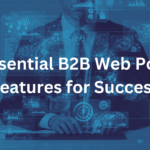Web Portal UX Design
Web portal UX (User Experience) design focuses on creating a seamless and intuitive experience that enables users to easily navigate, find information, and complete tasks efficiently within a web portal. By prioritising user-friendly interfaces, logical navigation, and mobile responsiveness, effective UX design boosts user satisfaction and engagement. Whether for intranets, customer portals, or specialised platforms, strong web portal UX is essential for meeting user needs and achieving business goals.
When planning your web portal UX design, a well-optimised B2B web portal is crucial for businesses looking to streamline their operations and enhance customer satisfaction. A user-friendly portal can significantly impact your bottom line by improving efficiency, reducing support costs, and fostering stronger relationships with your clients. This article will guide you through the essential steps to optimise your B2B portal for a better user experience.
Conduct User Research
Understanding User Needs
The foundation of any successful B2B portal optimisation strategy lies in understanding your users' needs and their pain points. Conducting thorough user research is essential to gain insights into how your clients interact with your portal and what improvements they desire.
To gather this valuable information, consider employing a mix of qualitative and quantitative research methods. Start by analysing your portal's analytics data to identify patterns in user behaviour, such as frequently visited pages, typical user paths, and areas where users tend to drop off.
Qualitative
Qualitative research methods are exploratory approaches that collect non-numerical data to understand concepts, opinions, or experiences. They focus on gathering in-depth insights through methods like interviews, focus groups, and observations.
Quatitative
Quantitative research methods are systematic approaches that collect and analyse numerical data to find patterns and averages, make predictions, and generalise results to wider populations. They use measurable data to formulate facts and uncover patterns, often through surveys, experiments, and statistical analysis.
Follow up this research with surveys and questionnaires to collect direct feedback from your users. These can be particularly useful for understanding specific pain points and gathering suggestions for improvements. Don't shy away from open-ended questions that allow users to express their thoughts freely.
In-depth interviews with key clients can provide a wealth of information about their experiences with your B2B portal. These conversations often reveal nuanced issues and opportunities that may not be apparent from quantitative data alone.
User testing sessions, where you observe clients interacting with your portal in real-time, can be eye-opening. These sessions often uncover usability issues that users themselves might not think to mention in a survey or interview.
Lastly, don't forget to involve your customer-facing teams, such as sales and support staff. They often have valuable insights into common user challenges and requests.
User Personas
Once you've gathered a wealth of user data, the next step is to synthesise this information into user personas. These fictional representations of your typical users help guide design and functionality decisions throughout the optimisation process.
To create effective user personas, start by identifying common patterns in your research data. Look for shared characteristics, goals, and pain points among your users. You might find that you have several distinct types of users, each with their own needs and preferences.
For each persona, create a detailed profile that includes:
- Demographics: Age, job title, company size, industry, etc.
- Goals: What they aim to achieve using your portal
- Pain points: Common frustrations or challenges they face
- Behavioural traits: How they typically interact with technology
- Preferences: Their preferred features or functionalities
For example, you might have a persona named "Manager Dave", who represents mid-level managers in medium-sized manufacturing companies. Dave’s primary goal might be to quickly reorder supplies and track shipments, while his main pain point is navigating through complex menu structures to find the information he needs.
By referring to these personas throughout the optimisation process, you can ensure that your design decisions are always rooted in real user needs rather than assumptions or personal preferences.
Improve Site Performance
Page Load Speed
In the fast-paced world of B2B, every second counts. Slow-loading pages can frustrate users, leading to abandoned sessions and lost business opportunities.
To optimise your portal's loading speed, consider the following strategies:
- Minimise HTTP requests by combining files where possible and using CSS sprites for images.
- Enable browser caching to store static files on users' devices, reducing load times for repeat visitors.
- Compress images and use modern formats like WebP for faster loading without sacrificing quality.
- Implement lazy loading for images and videos, so they only load when needed.
- Use a content delivery network (CDN) to serve static content from servers geographically closer to your users.
- Optimise your database queries to reduce server response times.
- Minify and compress your CSS, JavaScript, and HTML files to reduce their size.
Regularly test your portal's speed using tools like Google PageSpeed Insights or GTmetrix to identify areas for improvement and track your progress over time.
Server Reliability
Even the fastest-loading pages are useless if your portal is frequently down or experiences performance issues. Ensuring robust server reliability is crucial for maintaining user trust and satisfaction.
Invest in a reliable hosting solution that can handle your web portal's traffic and provide consistent uptime. Consider using cloud-based solutions that offer scalability to accommodate traffic spikes during busy periods.
Implement a comprehensive monitoring system to alert you to potential issues before they impact users. This should include monitoring of server health, application performance, and key business metrics.
Regular maintenance and updates are essential for keeping your portal running smoothly. Schedule these during off-peak hours to minimise disruption to your users.
Lastly, have a solid disaster recovery plan in place. This should include regular backups and a clear process for quickly restoring service in the event of a major outage.
Enhance Content Quality
Relevant and Up-to-Date Information
The content on your B2B portal should be a valuable resource for your users, not just a static brochure. Providing relevant, accurate, and up-to-date information is crucial for keeping users engaged and encouraging repeat visits.
Develop a content strategy that aligns with your users' needs and your business goals. This may include:
- Detailed product information and specifications
- Industry news and trends
- How-to guides and low-code development best practices
- Case studies and success stories
- FAQs and troubleshooting guides
Regularly review and update your content to ensure its accuracy and relevance. Consider implementing a content management system (CMS) that allows for easy updates and version control.
Engaging Visuals and Media
While B2B portals are primarily functional, that doesn't mean they should be visually dull. High-quality visuals and media can significantly enhance user engagement and comprehension.
Use professional-quality product images and videos to showcase your offerings. Consider adding 360-degree views or interactive product demos where appropriate.
Infographics can be an effective way to present complex information or data in an easily digestible format. Use them to illustrate processes, comparisons, or trends relevant to your users.
If your web portal includes training materials or guides, consider incorporating video tutorials or interactive simulations to enhance learning.
Remember to optimise all visual content for web use to maintain fast loading times. Use appropriate file formats and compression techniques to balance quality and performance.
Streamline Navigation
Simplified Menu Structures
Complex, cluttered navigation is a common pain point for B2B portal users. Streamlining your menu structure can significantly improve user experience and efficiency.
Start by conducting a content audit to identify and remove redundant or outdated pages. Group related content logically and use clear, descriptive labels for menu items.
Consider implementing a mega menu for portals with a large amount of content. These expanded dropdown menus can provide users with a comprehensive overview of available options without overwhelming them.
Use data analytics to identify the most frequently accessed pages and ensure they're easily accessible from the main navigation. Consider adding a "quick links" section for these popular destinations.
For portals with complex functionality, consider implementing a task-based navigation structure. This approach organises menu items around common user tasks rather than traditional categories, making it easier for users to find what they need.
Clear Call-to-Actions
Strategic placement of clear call-to-actions (CTAs) can guide users through your portal and encourage desired behaviours. Each page should have a primary CTA that aligns with the user's likely intent for visiting that page.
Design your CTAs to stand out visually while maintaining consistency with your overall design aesthetic. Use action-oriented language that clearly communicates what will happen when the user clicks.
For important CTAs, consider using A/B testing to optimise their placement, design, and wording for maximum effectiveness.
Offer Personalised Experiences
Custom Dashboards
One size rarely fits all in a B2B working environment. Allowing users to customise their dashboard can significantly enhance their experience by putting the information and tools they need most front and centre.
Implement a modular dashboard system that allows users to add, remove, and rearrange widgets according to their preferences. Common widgets might include:
- Recent orders and their status
- Quick reorder options for frequently purchased items
- Account balance and payment information
- Support ticket status
- Personalised notifications and alerts
Provide a mix of default layouts tailored to different user personas, with the option for users to further customise as needed. This approach ensures that even less tech-savvy users can benefit from a personalised experience.
Tailored Recommendations
Leverage the power of data to provide users with personalised content and product recommendations. This not only enhances the user experience but can also drive additional sales and engagement.
Implement a recommendation engine that analyses user behaviour, purchase history, and other relevant data to suggest products or content that may be of interest. These recommendations can be displayed on the dashboard, product pages, or in targeted email campaigns.
Consider offering personalised pricing or special offers based on the user's history with your company. This can help foster loyalty and encourage larger orders.
Use personalisation to streamline the ordering process by pre-filling forms with commonly used information and suggesting frequently ordered items.
Web Portal UX Design and Optimisation Summary
Web portal UX design and optimisation is not a one-time task but an ongoing process of improvement. By focusing on user research, site performance, content quality, navigation, and personalisation, you can create a portal that truly meets the needs of your clients and drives business growth.
Remember that the key to successful optimisation lies in understanding your users and making data-driven decisions. Regularly collect and analyse user feedback and behaviour data to identify areas for improvement and measure the impact of your optimisation efforts.
A well-optimised B2B portal can lead to increased user satisfaction, improved efficiency, reduced support costs, and ultimately, stronger client relationships and increased revenue.
Now that you're armed with strategies for optimising your B2B portal, it's time to take action. Start by assessing your current portal against the areas we've discussed in this article. Identify your top priorities for improvement and develop a roadmap for implementing changes.
Remember, even small improvements can have a significant impact on user experience and business outcomes. Don't be afraid to start small and iterate based on user feedback and performance data.
If you need assistance with your portal optimisation efforts, our team of B2B web specialists are here to help.
Here at Applications Platform we provide you with market-proven web portal development services that have been tried and tested in a wide range of B2B business scenarios. Our enterprise-level web portal solutions are fully integrated with your existing business systems, powered by low-code technology and are feature rich with the required web portal features to streamline processes and enhance customer satisfaction.
Our Professional Services team helps you to simplify the portal development process including planning, development, customisation and deployment to help you go to market quickly, on time and within budget.
If you’re looking to transform your business through B2B portal software, download the datasheet below or call us on +44 (0) 330 99 800 50.

